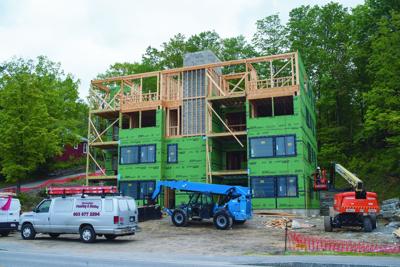LACONIA — An update to the city’s master plan could happen as soon as next year, councilors learned at their meeting Tuesday night.
City Planning Director Rob Mora told councilors he’s seeking, as part of his budget proposal, $100,000 for an update to the master plan. A municipal master plan is a document outlining a long-term blueprint to guide growth and development and considers numerous facets of city operations. The plan would likely include a comprehensive municipal housing needs assessment.
The last update to the master plan was completed in 2018. It is brief, at just 18 pages. For comparison, a master plan completed in 2007 is 128 pages long, and much more comprehensive.
“That will give us the true direction so that zoning board, planning board and city council — we’re all on the same page, we’re all on the same team collaboratively working forward towards the ultimate goal,” Mora said. “I think that’s our true objective with that master plan.”
“I would argue that we need it because right now, I think a lot of people — planning board, zoning board, city council — have a sense of what we need and have a sense of what’s going on, but we don’t have the facts,” Ward 3 Councilor Eric Hoffman said.
In a discussion regarding housing in the city, councilors stressed the importance of hard data in quantifying the scale of need. A housing needs assessment, essentially a study of where the city stands and where it looks like it's going, would provide councilors and department heads with the information needed to make informed decisions regarding housing development and the municipal zoning ordinance.
Tyler Carmichael, the city’s planning assistant director, told councilors that both the going rates of housing and its availability vary widely across real estate listing platforms. Between four major real estate listing websites, the average home value in the city is $442,478 — but none of the four sites capture every listing, and it's probable every listing isn’t accounted for between all four. Based on the same data, the average monthly rent in Laconia is $1,641.
In fiscal year 2025, the city’s planning department approved 220 units of housing — 13 of those were single-family units and 207 were multi-family. Of those 220 units, 16 offered workforce housing rates, as defined by state law. All workforce housing units were multi-family. Workforce housing rates, as defined by state law, depend on a given household size and income. At the high end, monthly rent for a household with an annual income of $63,360 is $1,584, including utilities. For ownership, a household with an income of $117,300 is $2,932, including insurance and taxes.
“I think we kind of need to drill down — what workforce housing do we need? I see out of 220 units, we have 16 units coming online of workforce housing. Is that good? You look at it one way as a percentage, it’s like, ‘Well, we’re doing something,'” Hoffman said. “In another way, that’s not enough workers to run a grocery store, let alone serve all of the business in the community.”
Workforce housing is defined by RSA 674:58-674:61 as housing that’s affordable to: a renter family of three earning 60% of area median income; owner family of four earning 100% of AMI; does not include age-restricted housing; does not include developments where more than 50% of units have less than two bedrooms; and no more than 30% of income is spent on housing, including rent plus utilities or mortgage principal and interest plus insurance and taxes, among other metrics.
Municipalities are required by law to provide “reasonable and realistic opportunities for the development of workforce housing, including rental and multi-family housing”. The RSA outlines means by which compliance could be measured, though vague, but doesn’t provide any mechanism to achieve or enforce it.
AMI is defined by the U.S. Department of Housing and Urban Development, and for Belknap County is $120,300 — 50% of AMI is $60,150, and 80% of AMI is $96,240. For a single-person household, 100% of AMI is $60,550.
The typical city homeowner, according to census data, earns much more than the typical renter, is much older and spends proportionately much less of their income on housing. Of households in Laconia, 64% are owner-occupied. According to the census, typical owners are individuals aged 65 to 74 earning between $100,000 and $149,999, who spend less than 30% of their income on shelter. Renter-occupied dwellings comprise 37% of households. Census data points to renters typically as people aged 35 to 44 who earn between $50,000 and $74,999, while spending more than 30% of their income on housing expenses.
Master plan aside, Mora asked for funding for a project manager to join the planning department. That individual, if the position were created this budget cycle, would work hand-in-hand with real estate developers on projects within city limits. They’d act as a go-between, hopefully ensuring all city departments are on the same page, and help developers navigate what is at times a byzantine bureaucracy.
With development in the city increasing and the anticipation of about 2,000 units of housing associated with the State School project, the planning department is as busy as ever, Mora told councilors. The planning department is often the first stop on the road to development, and Mora described his staff as the “boots on the ground”.
“I also took a look at the Lakes Region Planning Commission’s predictions for the Lakes Region and Laconia specifically, and they’re predicting that Laconia will need 1,180 housing units by 2040, which is based off of 2020 numbers,” Carmichael said. “It’s 59 units per year from 2020 through 2040 and, as you can see, we are exceeding that 59-unit goal that they have set for us. Again, they’re looking at the county as a whole, not necessarily looking at just Laconia — I would prefer to have something that looks at just Laconia so I can tell you guys with confidence, ‘Yes, this is what we need.’”
In 2022, the planning department approved 123 units of housing, 73 in 2023, 250 in 2024 and 64 to date in 2025, though Mora said he anticipates that number to grow through the end of the year. Another 470 units were previously approved and are under construction, and there are an additional 33 units which were approved but haven’t been started. For each of those years outlined in the data, some units are under construction, some are not yet started, and some are complete, and all of those developers started the process at the planning department.
“We already know of at least three or four subdivisions that have yet to come in and speak with us,” Mora said regarding the remainder of 2025.
“I expect this number to continue to grow.”
Editor's note: This story has been updated to clarify statistics about owner and renter demographics which came from census data.


















(0) comments
Welcome to the discussion.
Log In
Keep it Clean. Please avoid obscene, vulgar, lewd, racist or sexually-oriented language.
PLEASE TURN OFF YOUR CAPS LOCK.
Don't Threaten. Threats of harming another person will not be tolerated.
Be Truthful. Don't knowingly lie about anyone or anything.
Be Nice. No racism, sexism or any sort of -ism that is degrading to another person.
Be Proactive. Use the 'Report' link on each comment to let us know of abusive posts.
Share with Us. We'd love to hear eyewitness accounts, the history behind an article.